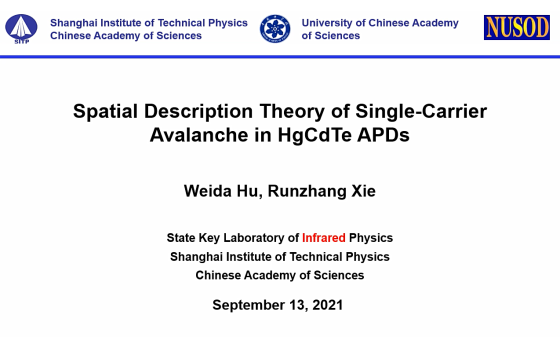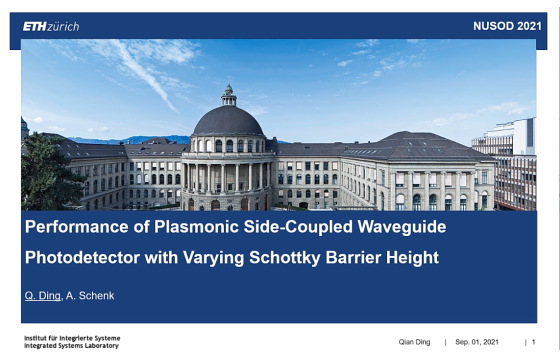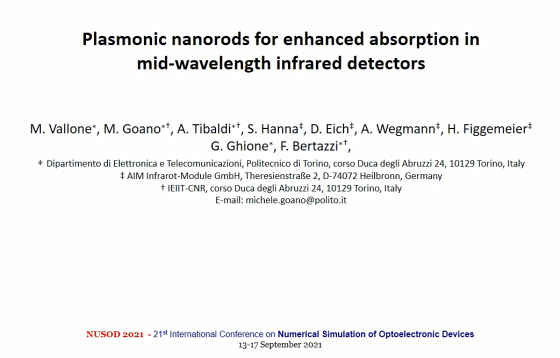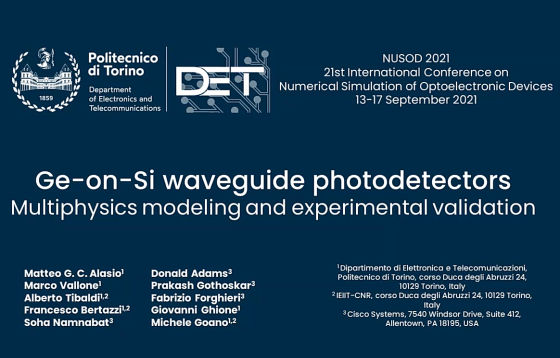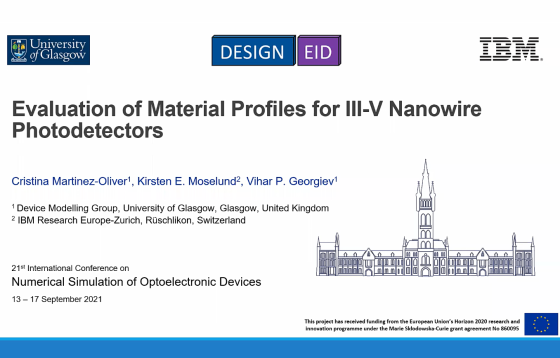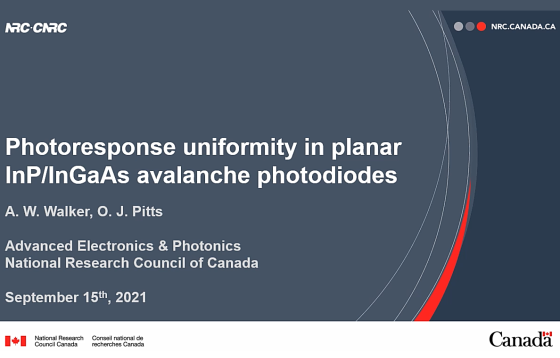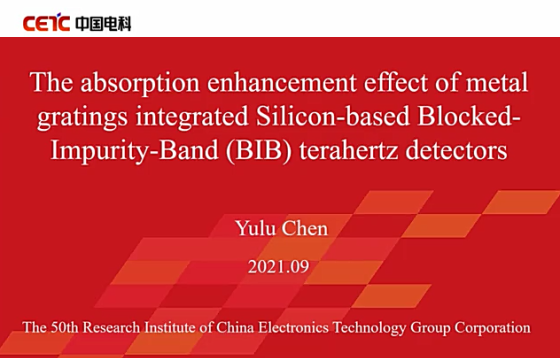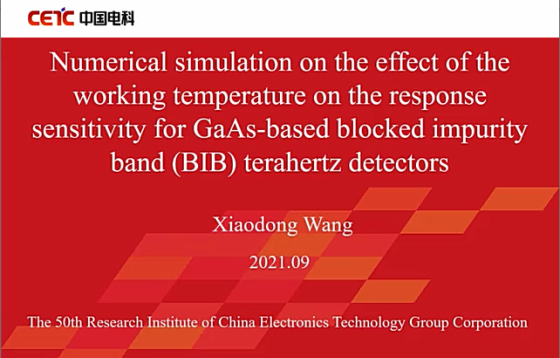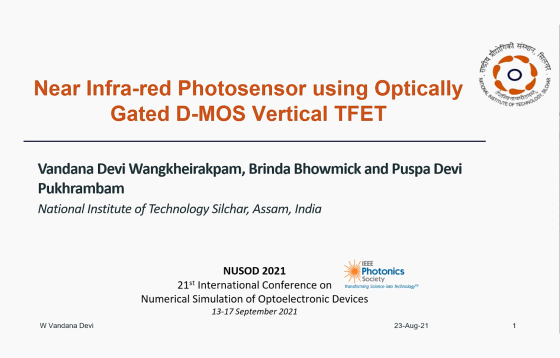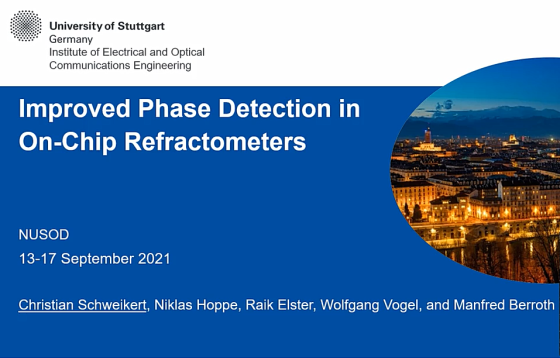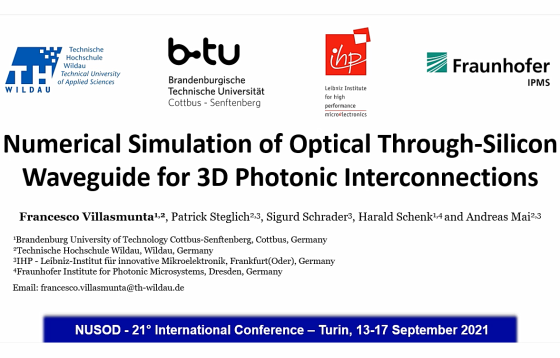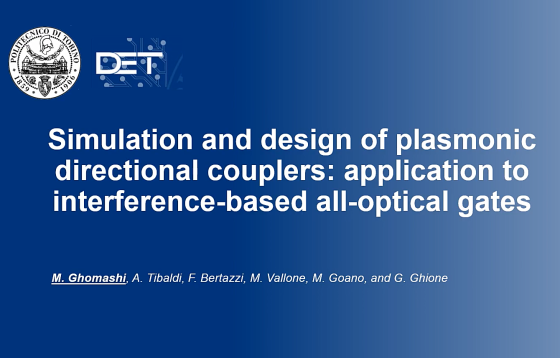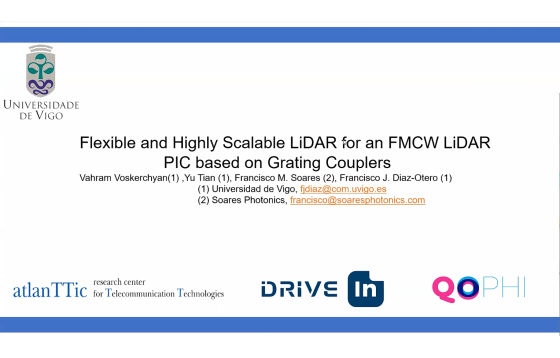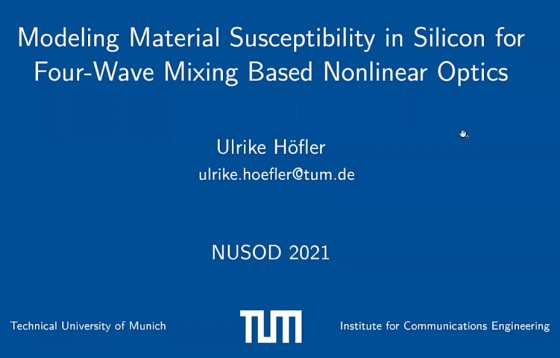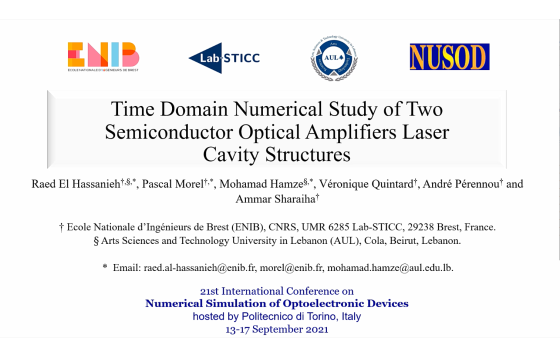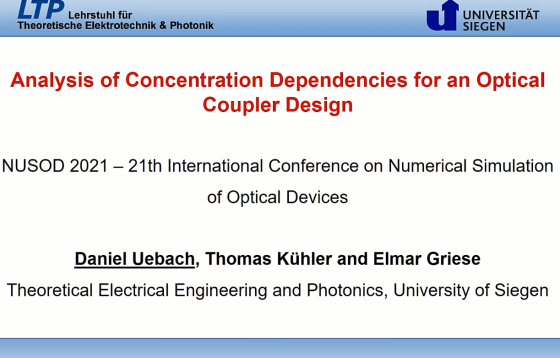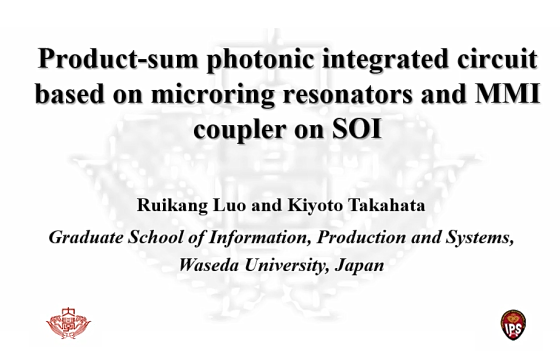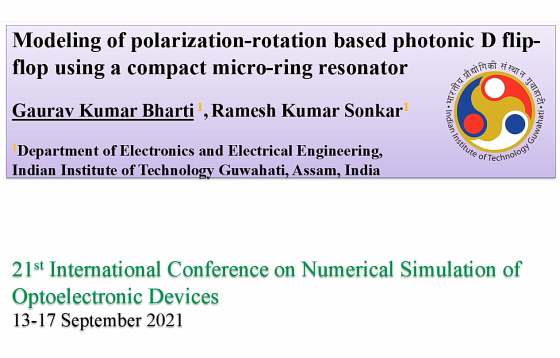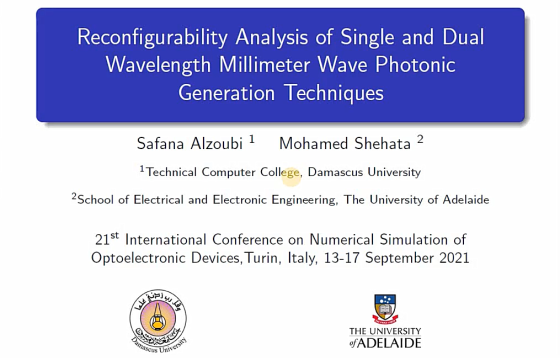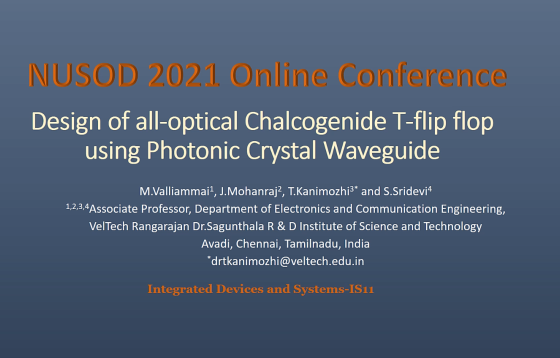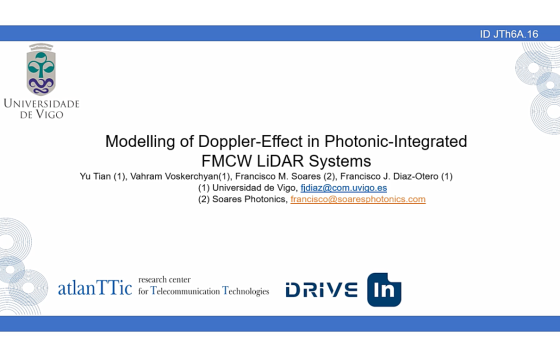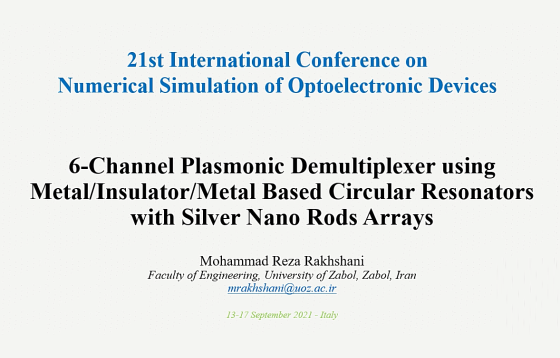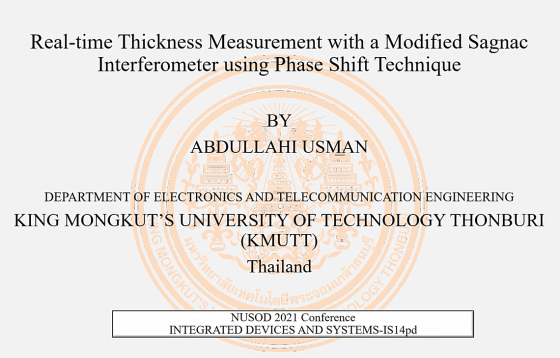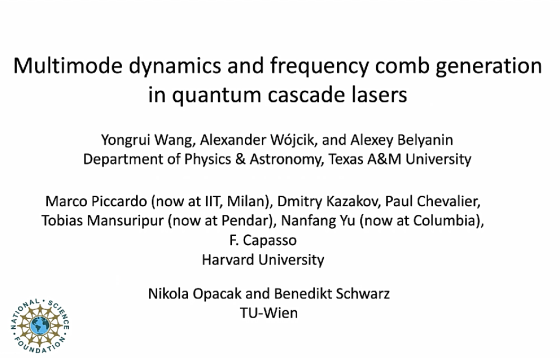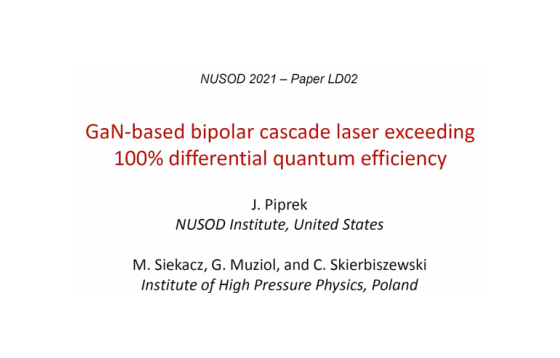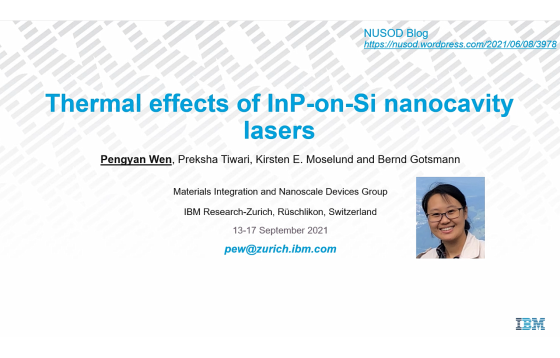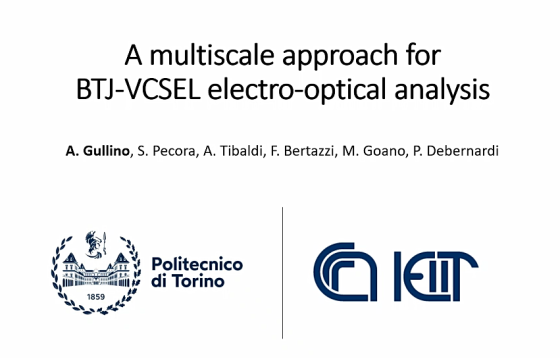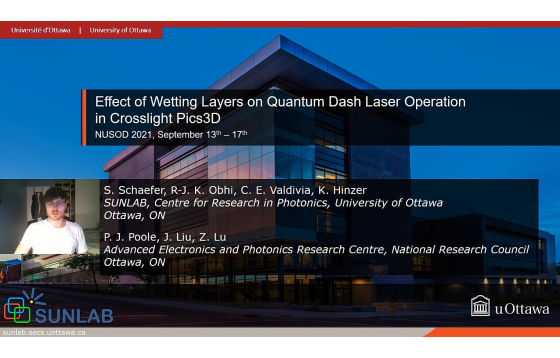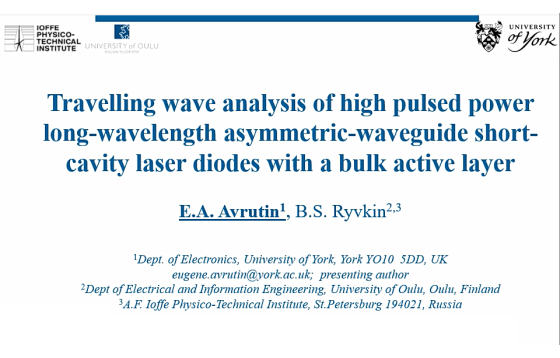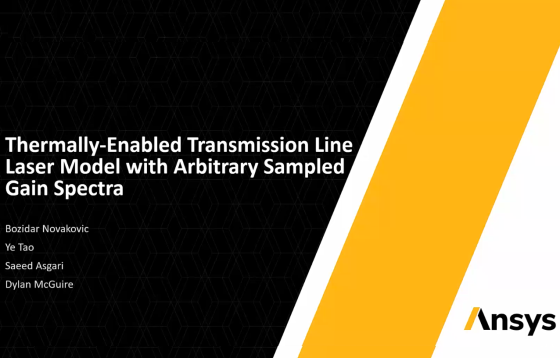


Recent researches have proven that HgCdTe is a good material to acquire both high multiplication and low excess noise factor at the same time in avalanche photodiodes (APDs). As a pseudo-binary narrow bandgap semiconductor material, HgCdTe exhibits high conduction band nonparabolicity as well as strong alloy scattering, especially for hot electrons, which changes the dynamics […]
D02–Performance of Plasmonic Side-Coupled Waveguide Photodetector with Varying Schottky Barrier Height
The impact of Schottky barrier height (SBH) on the performance of a side-coupled plasmonic waveguide photodetector (WGPD) is theoretically investigated by 3D optoelectrical simulations. A general decrease of the cut-off frequency is observed for all studied barrier heights (0.1 eV to 0.6 eV), most pronounced in the range (0.3 – 0.4) eV. The degradation is […]
D03–Plasmonic nanorods for enhanced absorption in mid-wavelength infrared detectors
The absorption properties of HgCdTe based infrared detectors can be greatly increased in the mid-infrared band, by incorporating nanostructured plasmonic arrays on the illuminated detector face. The array periodicity, combined with the excitation of surface plasmon-polariton stationary modes, enhances the absorption efficiency by a substantial amount, allowing to reduce in turn the HgCdTe absorption thickness.
D04–Ge-on-Si waveguide photodetectors: multiphysics modeling and experimental validation
This work compares a multiphysics modeling approach with experimental measurements of two Ge-on-Si butt-coupled waveguide photodetectors. The coupled three dimensional electromagnetic and electrical simulation of the frequency response shows promising agreement with the measurements at 1310 nm, and provides detailed information about significant microscopic quantities, such as the spatial distribution of the optical generation rate.
D05–Evaluation of material profiles for III-V nanowire photodetectors
In this paper we report the simulation-based design of experiment (DoE) study for three different types of III-V based pin photodetectors operating at various wavelengths. Our DoE work shows that the optimal configuration for each device is strongly determined by the wavelength at which we are aiming to operate the photodetector and that a trade-off […]
D06–Photoresponse uniformity in planar InP/InGaAs avalanche photodiodes
Numerical simulation of the electric field distribution and photocurrent response of a planar InP/InGaAs avalanche photodiode is presented as a function of varying multiplication width. The Zn dopant diffusion front is obtained by numerically simulating the diffusion process. The simulation results indicate that while a local peak value of the electric field is observed near […]
D07–The absorption enhancement effect of metal gratings integrated Silicon-based Blocked-Impurity-Band (BIB) terahertz detector
High-sensitivity Terahertz (THz) detection technology is widely researched for its potential applications in astronomical observation, human security check, weak signal biomacromolecule detection, etc. In this work, a novel THz detector based on metal gratings/Si-BIB hybrid structure is theoretically simulated and successfully fabricated. From FDTD simulation results, the optical field is localized in the absorbing-layer region […]
D08–Numerical simulation on the effect of the working temperature on the response sensitivity for GaAs-based blocked impurity band (BIB) terahertz detectors
Working temperature is a critical parameter to evaluate the performance of Gallium Arsenide (GaAs) blocked impurity-band (BIB) terahertz detector. An optimal devicetemperature can ensure the best response sensitivity. Therefore, we analyze the effect of device temperature on the response sensitivity characteristics of GaAs-based BIB detector by numerical simulation. The simulated result shows that the optimal […]
D09–Near Infra-red Photosensor using Optically Gated D-MOS Vertical TFET
This article reports a highly sensitive and low power photosensor using dual MOSCAP Vertical TFET for near infrared light detection in the wavelength range 0.7µm to 1µm. The optical voltage (VOP) developed because of the photogeneration occurring within the gate region enhances the gate control over the channel and produces higher drain current. The sensitivity […]
IS01–Improved Phase Detection in On-Chip Refractometers
An improved phase detection scheme for Mach-Zehnder and bimodal interferometers is presented. By using a 90° hybrid, always two outputs operate at a highly sensitive point and the phase-shift-unambiguousness is extended to a range of 2π. The phase detection is independent of mode attenuations and input power fluctuations.
IS02–Numerical Simulation of Optical Through-Silicon Waveguide for 3D Photonic Interconnections
Optical interconnections are a promising step forward to overcome the intrinsic limitations of electrical interconnections in integrated circuits. In this work, we present a finite element method (FEM) simulation study of a dielectric waveguide etched through the full thickness of a silicon substrate. In particular, it is investigated the effect of the bridge-to-core size ratio […]
IS03–Simulation and design of plasmonic directional couplers: application to interference-based all-optical gates
The paper is focused on the design of optical components based on plasmonic multi-slot directional couplers. In particular, the design of an all-optical gate is proposed, whose operation is based on the coupling between three plasmonic slots. The device input wavelength is 1550 nm, typical of long-haul telecommunication systems. The device footprint is as small […]
IS04–Flexible and Highly Scalable LiDAR for an FMCW LiDAR PIC based on Grating Couplers
In this paper three types of Silicon Photonics OPA architectures are proposed and investigated. Edge-fire optical phased array, that simplifies the design of the OPA. Second architecture is OPA with grating coupler antennas. Maximum steering angle for edge-fire OPA is ±44◦, FWHM is 0.10986◦. For GC OPA steering angle is ±20◦ and FWHM=1.003116◦. Third architecture […]
IS05–Modeling Material Susceptibility in Silicon for Four-Wave Mixing Based Nonlinear Optics
We model the third-order material susceptibility chi3 in silicon waveguides for integrated optics. Analysis of four-wave mixing in these waveguides requires an in-depth study of material nonlinearity – in contrast to modeling light propagation in fibers with the optical nonlinear Schrödinger equation. We include electronic and atomic lattice (Raman) responses of the material and present […]
IS06–Time Domain Numerical Study of Two Semiconductor Optical Amplifiers Laser Cavity Structures
In this paper, we develop a time domain model of a Semiconductor Optical Amplifiers Fiber Cavity Laser (SOAFCL). The time domain characteristics of two different cavity configurations (bidirectional and one-way cavity) are compared. The study shows that one-way cavity is less noisy compared to the bidirectional cavity which presents higher output power.
IS07–Analysis of Concentration Dependencies for an Optical Directional Coupler Design
An integrated directional coupler is designed for a bidirectional communication on a single waveguide by separating both data streams within individual branches. Thereby, an adjustment of the numerical aperture of the transmitting branch is a promising optimization approach. As the couplers are manufactured by a field-assisted diffusion process the numerical aperture is directly related to […]
IS08–Product-sum photonic integrated circuit based on microring resonators and MMI coupler on SOI
A product-sum photonic integrated circuit consisting of SOI-based cascaded microring modulators and a 4×1 multimode interference coupler is proposed for CNN computing. A basic product-sum operation is numerically demonstrated for 2×2 matrix.
IS09–Modeling of polarization-rotation based photonic D flip-flop using a compact micro-ring resonator
This paper demonstrates the modeling and simulation of all-optical polarization rotation based clocked D flip-flop using a single micro-ring resonator. The simulated results show the switching time of 0.5 ps and the on-off ratio of 25.27 dB.
IS10–Reconfigurability Analysis of Single and Dual Wavelength Millimeter Wave Photonic Generation Techniques
Optimizing the operating conditions of a Mach-Zhender modulator (MZM) for different design requirements has drawn considerable research interests due to its key role as an electro-optic (EO) interface in hybrid access radio-over-fiber networks. In this work, we compare the modulation efficiency and the bit error rate (BER) performances of single and dual-wavelength-modulated millimeter-wave (MMW) photonic […]
IS11–Design of all-optical Chalcogenide T-flip flop using Photonic Crystal Waveguide
The field of designing photonic crystal based all optical devices is the recent research trend as it remarkably promises an opportunity to diminish circuit complexity. The main intention of this present work is to contrive novel photonic crystal waveguide based all optical chalcogenide T-flip flop. Finally the efficient performance is numerically demonstrated to show elevated […]
IS12pd–Modelling of mid-IR on-chip Doppler FMCW LiDAR System
We propose a generic model that can simulate the functioning of doppler LiDAR system from given target speed, working distance and modulation pattern. Simulations confirm that our model yield system performance consistent with the theoretical calculations.
IS13pd–6‑Channel Plasmonic Demultiplexer using Metal/Insulator/Metal Based Circular Resonators with Silver Nano Rods Arrays
In this paper, we design and propose a compact 6-channel plasmonic demultiplexer (DMUX), utilizing of metal/insulator/metal (MIM) circular resonators (CRs) with metal nano‑rod arrays (NRAs). The resonance wavelengths of the output ports depend on the number of metallic NRAs in the CRs. For the numerical examination of the designed scheme, the finite‑difference time‑domain (FDTD) technique […]
IS14pd–Real-time Thickness Measurement with a Modified Sagnac Interferometer Using Phase Shift Technique
The modified Sagnac interferometer with a phase-shift approach is given here for measuring Ta2O5 thin-film thickness. The input light is split into reference and sample beams. A real-time signal measurement is performed to get the output intensities of both beams with four different polarizer settings. These intensities can then be effectively converted into film thickness.
LD01–Multimode Dynamics and Frequency Comb Generation in Quantum Cascade Lasers
In this talk I will discuss how resonant light-matter interaction in the gain medium of quantum cascade lasers gives rise to a rich nonlinear multimode dynamics and a variety of phase-locked multimode regimes, most notably optical frequency combs with separation between the comb lines changing from one to many dozen round-trip frequencies. I will review […]
LD02–GaN-based bipolar cascade laser exceeding 100% differential quantum efficiency
Worldwide research efforts have been focusing on quantum efficiency enhancements of GaN-based light emitters. A promising approach is the separation of multiple active regions by tunnel junctions, enabling electron-hole pairs to generate more than one photon. Utilizing advanced numerical device simulation, we here analyze internal physics and performance limitations of such InGaN/GaN bipolar cascade laser […]
LD03–Thermal and optical simulation of InP on Si nanocavity lasers
Accurate prediction of thermal effects is important for scaled photonic devices as excessive heating may lead to device failure. This paper addresses numerical modeling of thermal properties of InP nanocavity lasers on Si combined with optical simulations in Lumerical and lasing threshold measurements. Different geometries with diameters ranging from 200 nm to 2 µm are […]
LD04–A multiscale approach for BTJ-VCSEL electro-optical analysis
This paper presents a theoretical comparison of the electro-optical characteristics of 850 nm GaAs/AlGaAs pinand BTJ-based VCSELs. The calculations are based on a drift-diffusion model coupled with a NEGF formalism, able to model accurately the tunneling across the TJ. The resulting LIV characteristics demonstrate promising improvements, at both 25 and 80 ◦C, enabled by TJ […]
LD06–Effect of Wetting Layers on Quantum Dash Laser Operation in Crosslight PICS3D
We discuss the integration of quantum dashes (QDashes) into laser simulations using Crosslight Pics3D, outlining the approach for developing a model featuring asymmetrical active regions. The importance of including wetting layers to accurately represent carrier transport is investigated using results obtained for an InAs/InP QDash laser. While leakage current across the active region is unaffected […]
LD07–Travelling wave analysis of high pulsed power long-wavelength asymmetric-waveguide short-cavity laser diodes with a bulk active layer
An effective one-dimensional travelling wave model is used to analyse the performance of a short-cavity asymmetric waveguide high pulsed power laser diodes. The effect of longitudinal inhomogeneity is proven to be modest for practical laser designs.
LD08–Thermally-Enabled Transmission Line Laser Model with Arbitrary Sampled Gain Spectra
In this paper we demonstrate a directly coupled opto-electro-thermal (OET) transmission line laser model (TLLM) for edge emitting laser simulations and its comparison to physical simulations and measurements. Our results show that the OET TLLM has comparable computational efficiency to the standard opto-electronic (OE) TLLM and can include self-heating effects with good accuracy. As such […]

